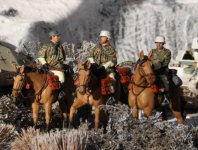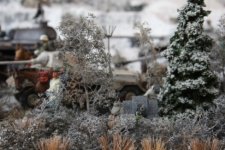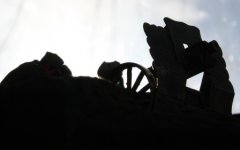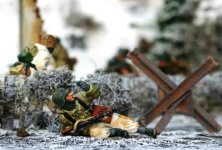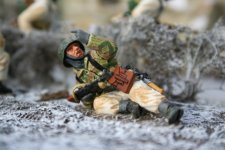panda1gen
Colonel
- Joined
- Jul 29, 2005
- Messages
- 8,127
Organic German Cavalry in WW2
German doctrine has always laid great emphasis on strong and aggressive reconnaissance at all echelons as a basis for dispositions and operations. This ranged from distant strategic reconnaissance by air forces and by large cavalry or motorized units to constant local patrolling by groups of four or five men from a rifle platoon.
In planning for World War II, the German High Command allotted a full, organic reconnaissance battalion to each division, except for coast defense and other static divisions. The organization of the battalion was identical in virtually all German infantry divisions and was retained without any essential change until 1943, except that there was a tendency in some units to replace the horses by bicycles.
Basically, the battalion consisted of one horse troop, one bicycle troop, a heavy weapons troop, and a communications platoon. The horse troop had three platoons (each of three squads) and a heavy machine gun section. The heavy machine gun section had 21 heavy machine guns; each squad had one light machine gun. The troop's strength was 205 men, 213 horses, and 3 horse-drawn wagons.
In 1943 a new and smaller type of infantry division was introduced in which the reconnaissance battalion was replaced by a shock infantry unit known as the Fusilier battalion. One company of this unit was mounted on bicycles while the rest were horse mounted. It had to serve both as the divisional reconnaissance element and as the reserve battalion for all three infantry regiments, which had been reduced to two battalions each.
The Germans experimented with even smaller divisional setups, but this Fusilier battalion was restored in the 1945-type division, with the horses eliminated and the entire battalion (except heavy weapons elements) mounted on bicycles. The employment of divisional reconnaissance battalions adhered to the usual principles of modern cavalry tactics. The units were used aggressively and skilfully for counter-reconnaissance, screening, flank protection, and covering withdrawals.
Though not strictly a part of the cavalry arm, the mounted platoon in the headquarters company of each infantry regiment in the German Army was used to spearhead regimental movements, for reconnaissance before and during action, and for screening and covering purposes. It consisted of three squads, a headquarters section, and a train, totalling 31 men and 31 horses. In later war operations some horses of the platoon were replaced by bicycles. This replacement was true of all divisions of the Volksgrenadier and 1945 types.
http://www.lonesentry.com/articles/germanhorse/index.html
German doctrine has always laid great emphasis on strong and aggressive reconnaissance at all echelons as a basis for dispositions and operations. This ranged from distant strategic reconnaissance by air forces and by large cavalry or motorized units to constant local patrolling by groups of four or five men from a rifle platoon.
In planning for World War II, the German High Command allotted a full, organic reconnaissance battalion to each division, except for coast defense and other static divisions. The organization of the battalion was identical in virtually all German infantry divisions and was retained without any essential change until 1943, except that there was a tendency in some units to replace the horses by bicycles.
Basically, the battalion consisted of one horse troop, one bicycle troop, a heavy weapons troop, and a communications platoon. The horse troop had three platoons (each of three squads) and a heavy machine gun section. The heavy machine gun section had 21 heavy machine guns; each squad had one light machine gun. The troop's strength was 205 men, 213 horses, and 3 horse-drawn wagons.
In 1943 a new and smaller type of infantry division was introduced in which the reconnaissance battalion was replaced by a shock infantry unit known as the Fusilier battalion. One company of this unit was mounted on bicycles while the rest were horse mounted. It had to serve both as the divisional reconnaissance element and as the reserve battalion for all three infantry regiments, which had been reduced to two battalions each.
The Germans experimented with even smaller divisional setups, but this Fusilier battalion was restored in the 1945-type division, with the horses eliminated and the entire battalion (except heavy weapons elements) mounted on bicycles. The employment of divisional reconnaissance battalions adhered to the usual principles of modern cavalry tactics. The units were used aggressively and skilfully for counter-reconnaissance, screening, flank protection, and covering withdrawals.
Though not strictly a part of the cavalry arm, the mounted platoon in the headquarters company of each infantry regiment in the German Army was used to spearhead regimental movements, for reconnaissance before and during action, and for screening and covering purposes. It consisted of three squads, a headquarters section, and a train, totalling 31 men and 31 horses. In later war operations some horses of the platoon were replaced by bicycles. This replacement was true of all divisions of the Volksgrenadier and 1945 types.
http://www.lonesentry.com/articles/germanhorse/index.html


